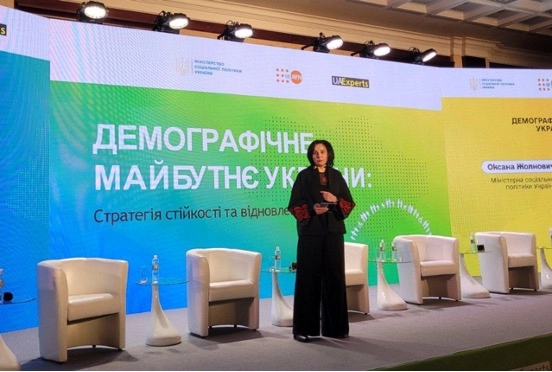Ukraine’s population decline is “very alarming” Ukrainian Minister of Social Policy Oksana Zholnovych told a public forum in Kyiv where the Social Policy Ministry delivered a report with strategies for overcoming the problem.
Over the past few years, Ukraine’s population has dropped by millions, Zholnovych said, speaking at the Demographic Future of Ukraine forum on Monday, April 22 where she was among those that delivered the report to an audience including Ukrainian politicians and scientists.
JOIN US ON TELEGRAM
Follow our coverage of the war on the @Kyivpost_official.
According to the United Nations Population Fund, Ukraine’s current population is estimated at 37.9 million.
In December 2001, according to the State Statistics Service, Ukraine’s population was 48.5 million. Two years ago, at the beginning of 2022, the National Academy of Sciences estimated Ukraine’s population was at 42 million.
By 2050, Ukraine’s population could drop by approximately another 10 million – down to 25.2 million, Zholnovych warned.

Ukraine, which already had a high emigration rate and a low birth rate, now also has a war, which worsens the situation.

ISW Russian Offensive Campaign Assessment, January 21, 2025
Estimates vary widely, but perhaps half a million Ukrainians have been killed since the start of Russia’s full-scale invasion in February 2022.
Also, according to the UN Refugee Agency in Ukraine, about 6.3 million people left the country in 2022-2023 due to fighting and Russian occupation.
Since 2014 – when Russia’s war on Ukraine first began with the occupation of Crimea and its backing of separatists in the Donbas region – there’ve been some 4.9 million “internally displaced” people, forced to leave their homes and relocate to other parts of Ukraine. Most of these – 3.6 million – were displaced after the full-scale invasion.
And while internal displacement doesn’t directly decrease your population, if you have to start over by living in a new place, you’re more likely to spend your time and resources integrating into a new community rather than having children.
Last year, with only 187,000 babies born, Ukraine had the lowest birth rate recorded in its modern history, Zholnovych said.
“In 2020, there were 210 deaths per 100 births. In 2021, there were 263 deaths per 100 births,” Oleksandr Gladun, the Deputy Director of the Ptukha Institute for Demography and Social Studies of the National Academy of Sciences, told Kyiv Post.
Meanwhile, the population is aging.
“It is expected that by 2035 every fifth Ukrainian will be over 65 years old,” the Ministry of Social Policy reported.
Even if Russia’s full-scale war on Ukraine ends tomorrow, the birth rate will likely remain low, Zholnovych said.
But the Ministry of Social Policy reported that there are things Ukraine can do.
“We don't have to wait for a victory to realize that we need to improve services, that we need to develop medicine very quickly, that we need innovations in prosthetic technologies and barrier-free access,” Zholnovych said.
The Ministry of Social Policy recommended strategies for overcoming Ukraine’s demographic problems, including:
- Encouraging growth in the birth rate by offering more support for families
- Reducing the number of people dying early by improving health care and educating people about health
- Getting more people to come to Ukraine – particularly by encouraging the Ukrainian diaspora to return to their homeland and by attracting foreigners to join Ukraine’s workforce
- Helping internally displaced Ukrainians integrate
- Developing mechanisms to improve the health/well-being of the elderly and encouraging them to stay active and involved in the workforce – particularly by creating flexible working conditions
- Improving the general quality of life – by bringing the war to an end, finding affordable housing for people, increasing people’s economic independence, improving infrastructure, and creating a socially cohesive environment
“These are the things we need to do now, and these things will make our Ukraine more competitive, more successful and attractive to return to tomorrow,” Zholnovych said.
Ella Libanova, director of the Institute of Demography of the National Academy of Sciences of Ukraine, said that in modern society, where women are often entering careers, there has to be flexibility for them to also have children. And elderly people have to be integrated into the workforce.
“We have to create specific jobs for people. We are talking about the need to create flexible working hours for women, for the elderly as well. We have to explain to society that older people are not ballast,” Libanova said.
Simply to avoid population decline, 100 Ukrainian women need to give birth to about 210-220 children, Gladun said.
“Before the war, 100 women gave birth to 120-130 children. That is half as many as needed.”
You can also highlight the text and press Ctrl + Enter










